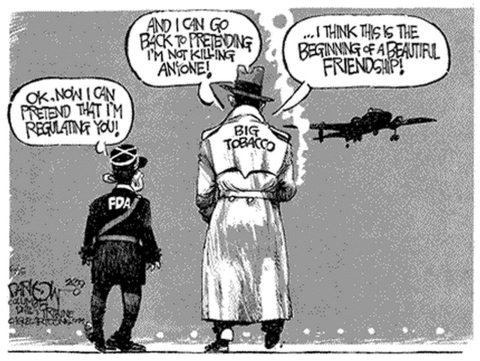What's Really Going On Behind Closed Doors When It Comes to Big Tobacco?

According to the CDC, over 36 million Americans smoke cigarettes regularly. This statistic is shocking considering the well-known effects that cigarette smoke have on the human body. Despite decades of numerous media campaigns and public education programs aimed at educating the public on the dangers of smoking, people continue to smoke away, fully aware that they are putting their lives in danger.
To fully understand why such a tremendous percentage of the population smokes cigarettes despite knowing their damaging effects, one must look into the way that the tobacco industry operates. To put it simply, the tobacco industry happily spends billions of dollars on finding ways to keep the public hopelessly hooked on cigarettes.
Big Tobacco
The term "Big Tobacco" refers to the five global tobacco companies that control the cigarette market. These companies include Philip Morris International, Imperial Brands, China Tobacco, Japan Tobacco International and British American Tobacco. Together, these five companies control 60 percent of the world's tobacco market power.
A little over 50 years ago, these companies had the advertising world at their fingertips. Thanks to loose regulations and little substantial research regarding the health risks of smoking, the major tobacco companies could market their products however they wished. Famously, cigarette advertising campaigns made up false claims regarding the positive health benefits of smoking.
On a more sinister note, this was also a time in which it was acceptable to market cigarettes to children. Fully aware of the addictive nature of cigarettes, tobacco companies focused much of their attention on getting kids hooked on smoking at a young age.
During the 1950s and 1960s, cigarettes were everywhere. The stars of family-oriented television shows smoked cigarette after cigarette on the screen. Magazines contained numerous advertisements for competing cigarette brands within each issue. You couldn't drive ten miles down a major highway without seeing an enormous billboard advertising a cigarette brand.
Celebrity endorsements were also a highly effective tactic of cigarette companies for decades. Celebrities like Lucille Ball, Bob Hope and Barbara Stanwyck were featured in cigarette advertisements.
By 1965, however, things started to change for the tobacco industry. With numerous studies emerging regarding the long term negative effects of tobacco smoke, regulations began to dictate how the tobacco industry could operate. That year, a law was passed dictating that all cigarette packs must contain a visible warning label. Just five years later, cigarette advertisements on television and radio were completely banned.
How Big Tobacco Continues to Thrive
Needless to say, the regulations that have been prompted by an increased public awareness regarding the negative consequences of smoking have been a tremendous blow to the tobacco industry. However, with hundreds of billions of dollars behind it, Big Tobacco has never taken too hard of a hit.
Without the ability to advertise freely, the tobacco industry has had to resort to sneakier ways in order to maintain its hold on the American public. Of course, the industry can only do so much as social attitudes toward smoking continue to evolve. Statistics demonstrate that overall, less people smoke today than they did fifty years ago. Additionally, statistics show that smoking among children and teenagers is at an all-time low.
One doesn't have to look far to see that social attitudes have changed regarding smoking over the last decade or so. Over the last ten years, regulations have been placed that forbid smoking in restaurants and even public parks.
Needless to say, Big Tobacco has had to get creative. Today's general public is too informed on the hazards related to smoking to fall for obvious tactics.
Philip Morris has been leading the way with experimental advertising methods. These methods include creating smokers' lounges sponsored by the brand for music festivals and offering financial incentives to bar managers who use the brand's logo on items like ashtrays and bar stools. Tobacco companies also offer incentives to convenience store owners who place the brand's cigarettes in a prominent place in the store. As teenagers visit convenience stores more frequently than adults, this tactic is a method for attracting young people to cigarettes.
The Newest Threat to Big Tobacco
Up until recently, it wasn't hard for the tobacco industry to maintain its clientele. With the powerfully addictive nature of cigarettes, tobacco brands could rely on the steady stream of revenue from its millions of addicted customers.
However, the power of technology has recently sent chills down the spine of Big Tobacco. Vaping has been proven to be a safe alternative to smoking cigarettes. It has also been proven as a highly effective method for quitting cigarettes.
Never before had there been such an effective treatment for quitting cigarettes. Now, the vaping industry continues to climb as the tobacco industry continues to fall.
Big Tobacco's Corrupt Tactics
Unsurprisingly, Big Tobacco is trying to fight back with all its might. What is has managed to do is conduct numerous studies that falsely conclude that vaping causes various serious health ailments. Of course, few people realize that the biased tobacco industry has conducted these studies in a shameful attempt to preserve its own reputation.
As a result of these false studies, the vaping industry has been unfairly scrutinized for its nonexistent health risks despite numerous studies debunking these blatant myths. However, Big Tobacco got the last laugh when the FDA finally stepped in and forced all vaping and e-cigarette products to follow certain guidelines.
Leading up to these recent regulations put in place by the FDA, tobacco industries had been lobbying heavily for them, claiming concern over their potential health hazards. Needless to say, it's hard to take the tobacco industry (that shamelessly claims about 500,000 lives each year) seriously when they raise concerns about the health risks associated with vaping. Clearly, Big Tobacco had a plan to wipe out the vaping industry as a whole.
These new FDA guidelines are costly for the little guys in the vaping industry. Meanwhile, Big Tobacco is beginning to invest in its own e-cigarette technology. In other words, the tobacco industry is simultaneously making up lies about the health hazards of vaping while preparing to launch its own e-cigarette products. Sounds strange, doesn't it?
Because of these new FDA regulations, it won't be hard for Big Tobacco to put small e-cigarette manufacturers out of business with its new competing products. Small e-cigarette manufacturers simply cannot afford to market their products while keeping up with the costs of these new regulations. On the other hand, large tobacco companies can certainly pay those fees and advertise their products without it putting a dent in their deep pockets.
What the future holds for the vaping industry is uncertain. Big Tobacco has demonstrated its terrifying power time and time again. All we can hope for is that the vaping industry remains free of corruption so that more and more Americans can discover the benefits of switching to vaping and say goodbye to cigarettes forever.
Author: David Nadel
Read more:
Northland Vapor VS Big Tobacco
An In-Depth Look at Big Tobacco
Big Tobacco Is Bad For Free Enterprise





